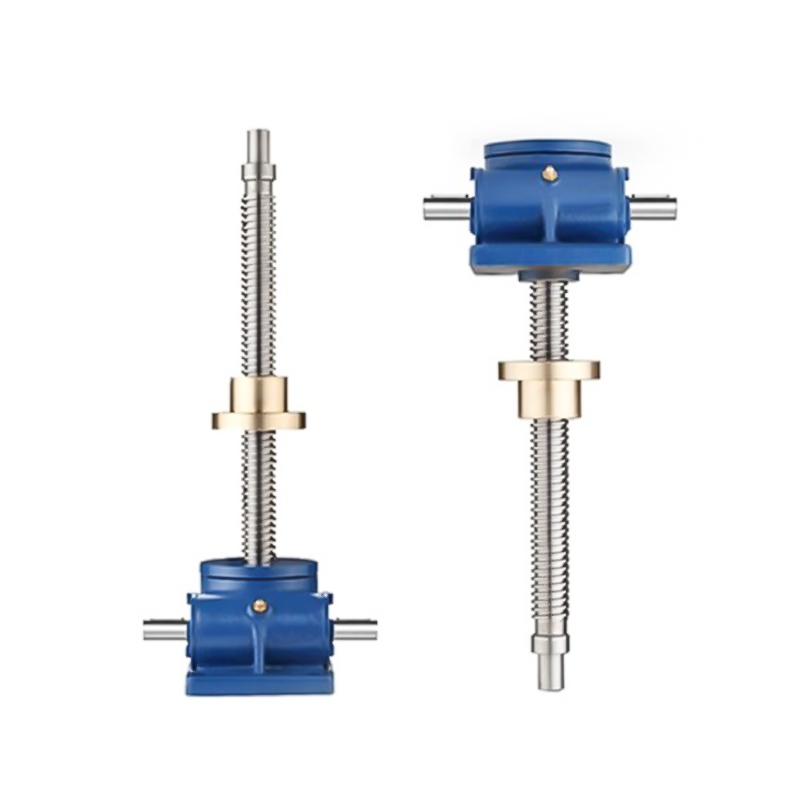Lifting screws and other mechanical lifting devices, such as hydraulic jacks, electric hoists, or chain hoists, each have their own characteristics when it comes to energy efficiency and operational costs. Below is a comparison of how lifting screws fare against these alternatives in terms of these factors:
1. Energy Efficiency
Lifting Screws:
Efficiency: Lifting screws, which operate on the principle of converting rotary motion into linear motion, generally have lower energy efficiency compared to hydraulic systems or electric hoists. The efficiency of a lifting screw is highly dependent on the lead (distance the nut moves per rotation) and the thread geometry (e.g., Acme, trapezoidal, or ball screw threads). Lifting screws tend to generate more friction due to the contact between the nut and the thread, which results in higher energy losses (often 30-50% efficiency for standard designs). However, the use of ball screws can improve efficiency to around 90% or more.
Energy Consumption: Lifting screws require a motor or manual force to turn the screw, which may consume more energy for heavy loads or high lifting speeds. As a result, they are often less efficient for large-scale operations where rapid lifting or large loads are involved.
Hydraulic Jacks:
Efficiency: Hydraulic systems typically have higher energy efficiency compared to lifting screws for lifting heavy loads because they utilize the pressure of a fluid to move a piston or lift, which is a very efficient process. The efficiency can range from 80-90% under optimal conditions.
Energy Consumption: While hydraulic jacks are energy-efficient, the energy consumption depends on the design and scale of the system. Larger hydraulic systems require pumps or motors, which consume energy, but the mechanical advantage they provide helps reduce the effort needed to lift heavy loads.
Electric Hoists:
Efficiency: Electric hoists are generally more energy-efficient than lifting screws, especially when lifting heavy loads at high speeds. Electric motors powering hoists are optimized for continuous lifting and can be very efficient (up to 90-95%). They often incorporate gearing systems that reduce power loss.
Energy Consumption: Electric hoists can be more energy-intensive for very high lifting speeds or heavy loads but are typically more energy-efficient over time compared to manual lifting screw systems, especially for frequent lifting operations.
Chain Hoists:
Efficiency: Chain hoists, which are powered either manually or electrically, generally have moderate energy efficiency. Manual versions require human effort, while electric versions (often used for heavy loads) have efficiency rates similar to electric hoists (typically around 85-90%).
Energy Consumption: For manual chain hoists, energy consumption is minimal (limited to human effort), while electric chain hoists consume more energy due to the motor used to lift loads. However, they still tend to be more energy-efficient than manual lifting screws in applications requiring continuous lifting.
2. Operational Costs
Lifting Screws:
Initial Cost: The initial cost of lifting screw systems is generally lower compared to hydraulic or electric hoists, especially for smaller, manual systems.
Maintenance: Lifting screws often require routine lubrication to reduce friction and wear. Over time, the threads or nuts can wear out, especially under heavy loads or with poor lubrication, which can result in higher maintenance costs. Additionally, mechanical parts may require periodic replacement of components like the screw, nut, or bearings.
Energy Costs: The energy cost of lifting screws tends to be higher due to lower efficiency, especially when lifting large or heavy loads. The manual effort required for smaller systems can also add to operational costs if frequent adjustments are needed.

Hydraulic Jacks:
Initial Cost: Hydraulic systems, especially for industrial applications, can have a higher initial cost due to the complexity of the hydraulic pump, cylinder, and other components.
Maintenance: While hydraulic jacks require less maintenance than lifting screws in terms of wear and tear, they still need periodic inspection for fluid leaks, seal integrity, and pump performance. Replacement of seals and maintaining fluid levels can add to costs.
Energy Costs: The energy consumption of hydraulic systems can be higher if using electric pumps or engines, but they are typically more efficient than lifting screws when lifting large loads, making their operational costs lower in large-scale lifting operations.
Electric Hoists:
Initial Cost: Electric hoists can have a higher initial cost due to the motor and control systems involved, but they are widely used in many industrial applications due to their efficiency in lifting heavy loads.
Maintenance: Electric hoists require periodic maintenance of their motors, gears, and control systems, although the maintenance is typically less frequent than for lifting screws. Upkeep for electric hoists is generally moderately priced.
Energy Costs: The energy cost of electric hoists is generally moderate, but they tend to be more cost-effective for frequent lifting operations. They can lift heavy loads quickly and efficiently, making them cheaper to operate in environments with high usage.
Chain Hoists:
Initial Cost: Manual chain hoists are relatively inexpensive, while electric chain hoists can be quite costly depending on the lifting capacity and features.
Maintenance: Chain hoists require maintenance of the chain, motor, and gears, but they are generally robust and have relatively low maintenance needs, especially for manual versions. Electric versions, however, will require occasional repairs or servicing of the motor or control systems.
Energy Costs: For manual chain hoists, there are no energy costs apart from human effort. Electric chain hoists have energy costs similar to electric hoists, but their overall energy efficiency can vary depending on the design.
| Lifting Device | Energy Efficiency | Operational Cost (Initial & Maintenance) |
|---|---|---|
| Lifting Screws | Lower (30-50% efficiency, 90% with ball screws) | Low initial cost, moderate maintenance and energy costs, higher operational cost for large/heavy loads |
| Hydraulic Jacks | High (80-90% efficiency) | High initial cost, moderate maintenance, moderate energy costs |
| Electric Hoists | High (90-95% efficiency) | High initial cost, moderate maintenance, moderate operational cost |
| Chain Hoists | Moderate (85-90% efficiency) | Moderate initial cost, moderate maintenance, variable energy costs depending on manual or electric |


 English
English 中文简体
中文简体 Español
Español русский
русский عربى
عربى







